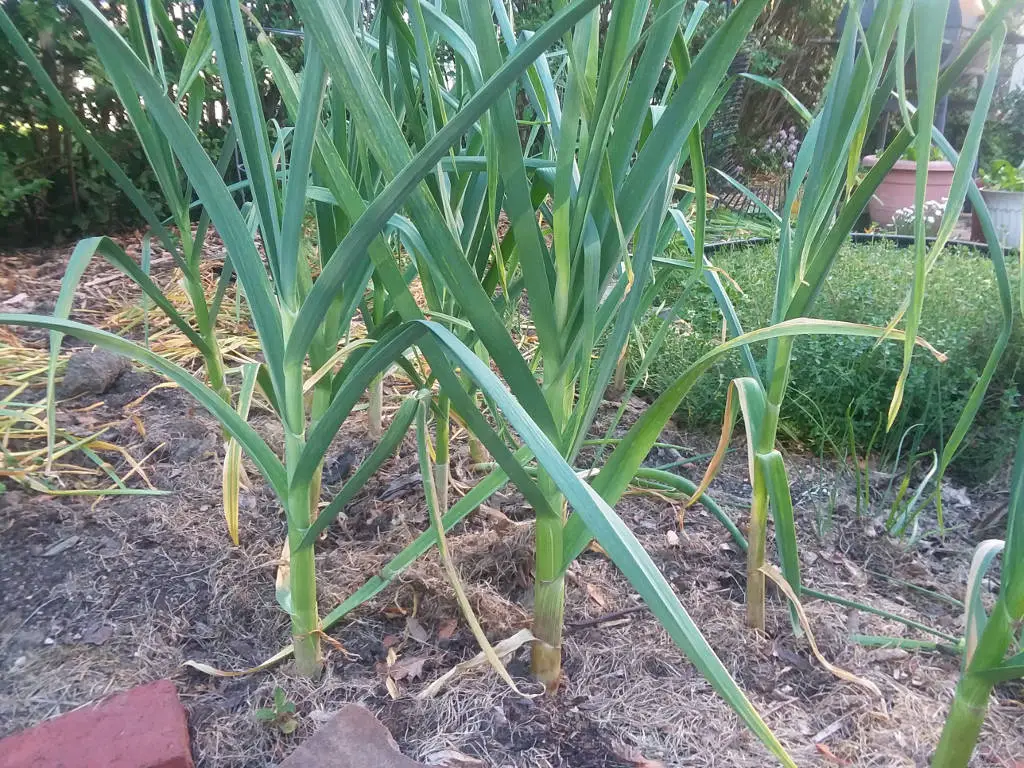How to Grow Garlic

How to Grow Garlic

Since my garlic is almost ready to be harvested, I thought it would be a great time to talk about growing your own garlic at home. If you’re like I was before I ever grew my own garlic, you may think that there is something magical or difficult about growing garlic, but you’d be dead wrong. Garlic is absolutely the easiest, most foolproof (and most delicious) crop I grow.
Why is Garlic My Favorite Edible to Grow?
- It’s pest-resistant. Occasionally a rabbit nibbles on one in the early spring, but generally the critters don’t like alliums such as garlic and onions.
- Low-maintenance. If you don’t water, fertilize or do anything else with it, it still generally grows great.
- It doesn’t take up much room. You can mix it in and around other plants, and by the time it is done, your other plants can take over the vacated space.
- It keeps for a really long time. Grow as much as you want. Unlike, say, tomatoes which we often find ourselves inundated with all at once and have to figure out how to use them all in that brief window of time before they go bad, garlic keeps for months and you can enjoy it at your leisure all winter long.
- It is delicious! What more can I say, I love garlic. Anyone who doesn’t isn’t to be trusted IMO. (Just kidding, sort of.)
How to Plant Garlic
First of all, yes, it is possible to grow garlic from seed, but that takes much longer to produce bulbs that you can harvest and eat. I’m going to discuss planting garlic cloves, which is the easiest and quickest method to grow garlic.
So where do you get garlic cloves for planting? You can buy them at the garden center, but honestly, I just save some garlic cloves from my plain old grocery store garlic and I’ve never had any problem. I know some will say that you shouldn’t use grocery store garlic, as it may be treated to keep it from sprouting, but just buy the organic kind, and you should be fine. If you grow enough the first year, you should have enough cloves for replanting so that you never have to plant store-bought again anyway.
There are two main types of garlic, hardneck and softneck and several different varieties within each of those types. In the north where I live (Northeast Ohio), both types seem to grow equally well. Hardneck can be distinguished by the thick, woody stem that grows up through the center of the garlic bulb. If you live in the south, you may need to stick with softneck (the everyday kind you find at the grocery store).

After I harvest my garlic, I start saving the best, largest cloves and throwing them in a paper bag for replanting in fall. Simply break them off from the bulb and leave the papery skin intact. The first time I grew garlic, I tried to grow the “runt” cloves that I didn’t want to deal with peeling, thinking if I fed them well and gave them plenty of time, maybe I could grow them into something more worthwhile. But that doesn’t work. If you plant tiny cloves, all you get are tiny plants and a bulb full of tiny cloves.
So as hard as it may seem, you have to sacrifice your best, biggest cloves for next year’s crop. This pays off though. The larger the clove you plant, the larger the bulb you’ll get, and it seems like I get bigger, better bulbs and cloves every year.
When to Plant Garlic
If you live in the northern part of the United States and have cold winters with a hard freeze, you will plant in the fall. Garlic is native to colder climates and needs a spell of below-freezing temperatures to grow bulbs otherwise they will simply put all their energy into the leaves. If you live in the south and don’t get a freezing spell of at least a few weeks, you may need to be more creative to get the bulb to grow. Check out this article on growing garlic in the south.
Assuming you do have cold winters, the only slightly tricky thing about growing garlic is planting at the right time. If you plant too early, the garlic will grow too much, too fast and then may get killed by winter freezing and snow. If you plant too late, the clove doesn’t have a chance to put out roots and might just rot or pop out of the frozen ground.
[ Related: Getting Greens in Your Diet When You’re Homebound ]
I have seen variations on planting schedules based on your hardiness zone, but my rule of thumb is to plant shortly after we get our first frost (within a week or two at most). This seems to work well. The weather inevitably is warming and freezing off and on after this point for at least a few weeks before things get really cold. Enough time for the clove to make roots and start to grow, but not too much.
Simply plant your cloves pointy side up in a nice, sunny area that won’t be disturbed throughout the winter and spring. You can amend the soil with compost and a variety of natural fertilizers, but I usually don’t bother. We have pretty crappy, heavy clay soil here where I live, and my garlic still grows great, so don’t stress about it too much. Just don’t plant it in an area that gets super swampy or it may rot.
Some of the cloves will start growing a little and will be poking above the ground as the snows and freezing really start to hit. Don’t worry about the garlic starting to grow a bit in late fall. Garlic is very tough and some ice and snow on the tips that are above ground won’t bother them at all.
That’s literally all you need to do with garlic until the following mid-summer when it’s time to harvest.
Note: The only other thing to be aware of: In the spring, if your garlic starts to grow these skinny, round, curly stem-like leaves that stick out of the top of the plant and clearly look different from the regular flat leaves, it’s best to cut those off. Those are called scapes and you’ll end up with smaller bulbs if you leave them on. You don’t have to just throw them out though. They are edible and many gardeners and chefs love to cook with them.
When to Harvest Garlic

I remember the first year I grew garlic, it all started turning brown and falling over by late June. I was so distressed. I assumed something must be wrong because there was still so much growing season left. But it turns out that it is totally normal for garlic to be done that early. So it’s pretty easy to know when to harvest garlic: when it turns brown and falls over, it’s done.
But if it has recently been rainy, wait to harvest. Ideally, you want several nice hot, dry days to pass before you harvest your garlic, otherwise your bulbs will be holding too much moisture and may rot in the center while in storage. You can also eat garlic straight away, fresh out of the garden, which is delicious, just more difficult to peel the outer paper off.
When I harvest, I leave the plants on an outdoor table to dry in the sun for another day or two if the weather isn’t calling for rain. Then I just throw all my garlic plants right into a big paper bag, leaving the tops on the plants to draw out even more moisture from the bulb. I leave the bag open for air circulation and leave the tops sticking out of the top of the bag.
To store long term, keep them in a dark location so they don’t try to re-sprout. I put mine in the basement. I check a few bulbs after a couple weeks to make sure they are not rotting in the center. (That only happened to me one year when it just wouldn’t stop raining and I couldn’t wait for several sunny, dry days in a row to harvest because there weren’t any.) If that happens to you, you can still save them by pulling all the cloves apart and letting them dry out. If you store them someplace dark and dry, they will keep for months.
That’s it! Enjoy your garlic growing!





The best, most uncomplicated, honest garlic write up I’ve read. Thank you for sharing your experience with us AND for making something easy in a world that often tells you you’ll fail if everything isn’t just perfect. Signed, Waiting for my first garlic, onion and shallot crop.
Thanks Nathan! I love garlic, it’s really one of the easiest edible plants to grow. Wish I could grow shallots, I have a hard time finding them around here.